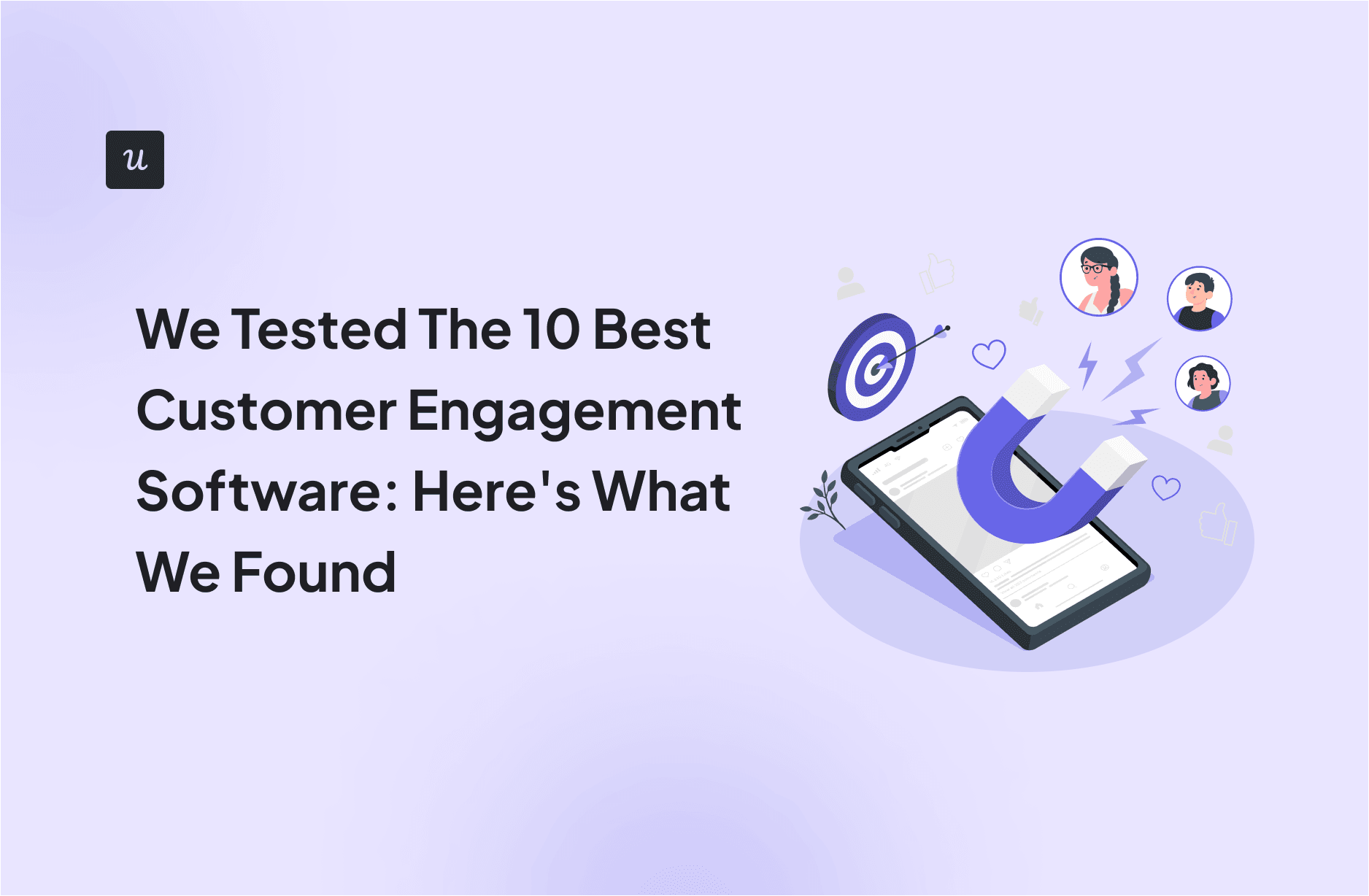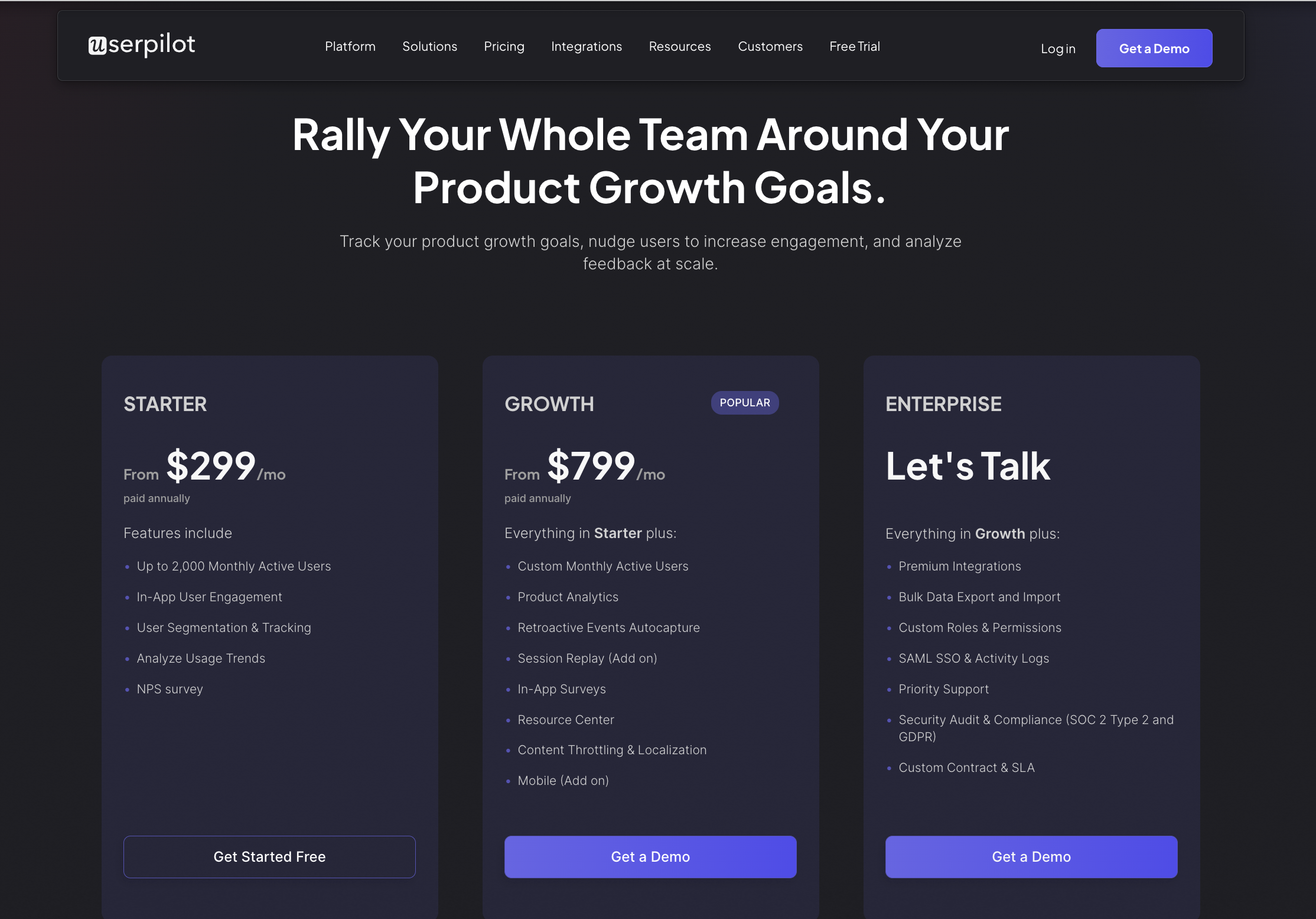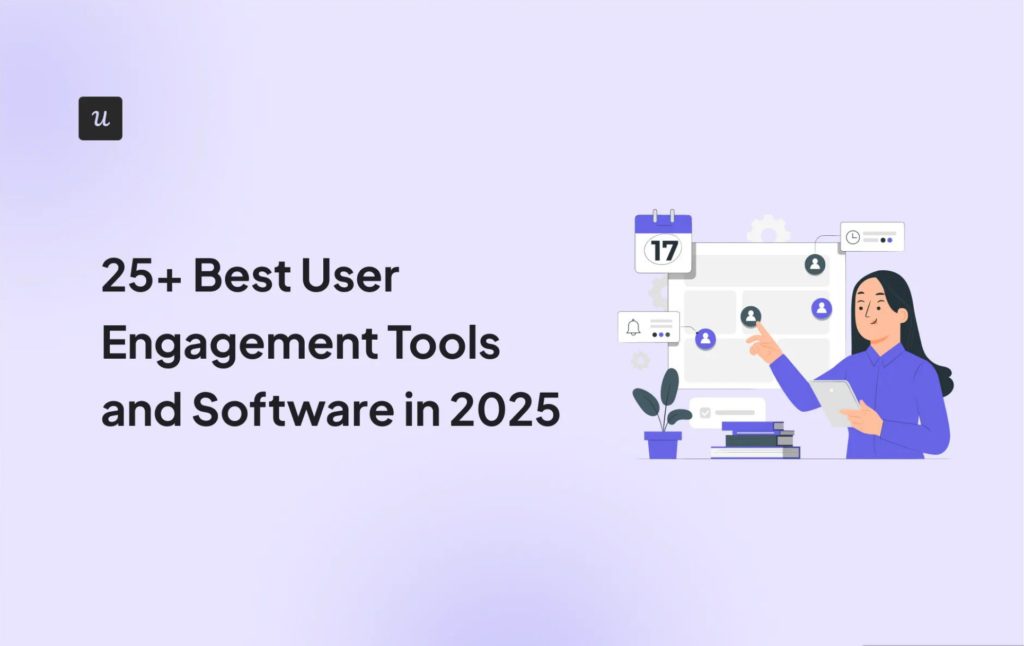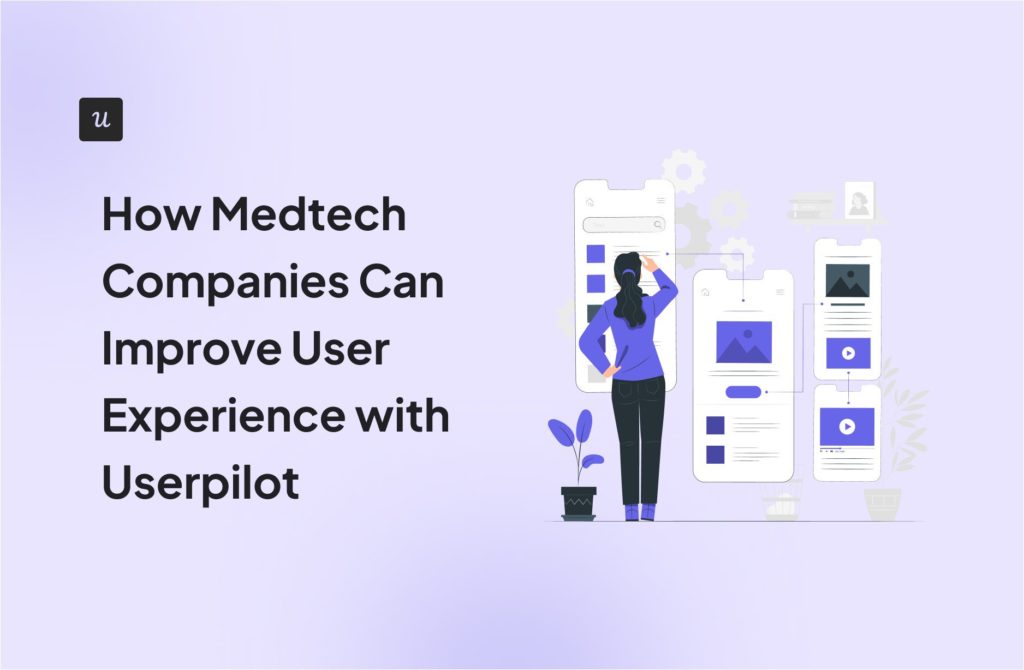
10 Best Customer Engagement Software: Tried & Tested by Userpilot
Customers who actively connect with your brand are more likely to stay loyal, spend more, and become advocates. But how do you track and strengthen these connections? That’s where customer engagement software comes in.
The right platform will equip you with the tools to interact effectively, gather valuable feedback, and build lasting customer relationships.
Get The Insights!
The fastest way to learn about Product Growth, Management & Trends.
How I chose the best customer engagement software
My evaluation process combined thorough feature analysis, a careful review of user feedback, and insights from industry reports. For each tool, I aimed to answer seven qualifying questions:
- Ease of use and implementation: How easy is it to get started and integrate the software with your existing tools?
- Features and functionality: Does the platform offer core engagement features, such as in-app flows, engagement tracking, and customer support?
- Integrations with other tools: Does it integrate with CRM, marketing automation, and other essential business applications?
- Customization options: Can you tailor the platform to match your brand identity and specific needs?
- Pricing: Is the pricing model transparent, and does it offer a free trial or a freemium version?
- Customer support: Does the vendor provide reliable and responsive customer support?
- Scalability and security: Can the platform grow with your business and protect your data?

The 10 best customer engagement software solutions
Here, you’ll find a quick overview, core features, and pricing information for each solution.
1. Userpilot
Userpilot tops the list because it’s an all-in-one tool that provides engagement solutions for every stage of the customer journey.
You can use this platform to create customer segments, personalize onboarding flows, deliver targeted in-app messages, collect direct customer feedback, and track in-app analytics to make iterative changes.

Best for: SaaS product teams who want a powerful but easy-to-use platform to improve onboarding, increase product adoption, and drive user engagement.
| Criterion | Does It Deliver? |
| Ease of use and implementation | ✅ Userpilot is known for its intuitive, no-code builder, making it easy to create and customize in-app experiences without needing developers. |
| Features and functionality | ✅ Offers a wide range of features, including interactive walkthroughs, checklists, in-app surveys, and feedback forms, all designed to drive product adoption and gather user insights. |
| Integrations | ✅ Integrates smoothly with tools like Segment, Google Analytics, Mixpanel, and HubSpot, ensuring data flows seamlessly across your tech stack. |
| Customization options | ✅ Provides extensive customization options, allowing you to tailor the look and feel of your in-app experiences to match your brand. |
| Scalability and security | ✅ Built to scale with your business, with enterprise-grade security measures to protect your data. |
How Userpilot increases customer loyalty + reduces churn
Don’t take my word for it. Here’s a real life example of how Userpilot helps SaaS companies boost engagement:
Before coming to Userpilot, Attention Insight struggled to engage new users and drive activation. The heatmap tool is your classic example of a product-led software: one-click free trial and easy-to-use interface, so what was the issue?
It turned out users didn’t quite understand how the key features worked. So, using Userpilot, the team at Attention Insight revamped their onboarding strategy to include a resource center, interactive walkthrough, an onboarding checklist, and other UI patterns that point new users in the right direction.
Additionally, Userpilot’s analytics helped them spot and address friction points in the onboarding flow. The result? A 47% increase in activation within a few months.
In the CMO’s words:
“Userpilot offered us the most content creation possibilities combined with the most extensive analytics for an affordable price.”
Userpilot’s top features:
- In-app flows: As in the example from Attention Insight, Userpilot allows you to create interactive walkthroughs and branched customer experiences using a variety of UI elements like modals, slideouts, tooltips, driven actions, hotspots, and banners. The best part? All these are available starting from the entry-level Starter plan.

- Session replays (new!): Userpilot lets you automatically capture user sessions and analyze their interactions with your product. For example, you can label key events like clicks on a new feature and use that data to track adoption, usage, and retention rates.

- User analytics: The custom analytics dashboard provides a centralized view of customer data, allowing you to segment, filter, and analyze user behavior. You can export data in bulk or drill down into specific segments to understand user journeys and identify trends.

- Feature engagement tracking: Userpilot’s click-to-track feature tagger lets you understand how users interact with your product over time. Besides tracking individual features, you can create custom events that group multiple features for clearer insights.

- Trends and funnels: These features help you analyze key events like feature usage or completion rates. You can segment users and add filters to narrow the data for more granular insights. For example, you could track the completion rate of your onboarding checklist and then filter by users who signed up within the last month to identify areas for improvement in that particular segment.

- Self-service support: Userpilot empowers you to build and customize in-app resource center code-free. You can include feedback widgets to collect feedback passively, checklists to walk users through specific processes, or integrations with knowledge bases to leverage existing documentation.

Userpilot pricing
Userpilot offers transparent and flexible pricing plans to suit different needs. The Starter begins at $299/month(billed annually), with a 14-day free trial for users to try the product without any financial commitment.

2. Intercom
Intercom is an AI-powered customer service tool that equips teams to engage customers through omnichannel support and activity-driven automation.

Best for: Sales and marketing teams who need customer engagement software to proactively interact with leads and customers, provide real-time support, and build stronger customer relationships.
| Criterion | Does It Deliver? |
| Ease of use and implementation | ✅ Intercom is easy to use and intuitive. The platform makes it easy to navigate and manage multiple conversations at once. |
| Features and functionality | ✅ Intercom offers an AI-powered chatbot called Fin AI, omnichannel and multilingual support, as well as features for in-app guidance. |
| Integrations | ✅ The platform integrates with Salesforce, Jira, Instagram, and WhatsApp. |
| Customization options | ❌ Intercom lacks deep customization options, especially for complex integrations and advanced reporting needs. |
| Scalability and security | ✅ Intercom is versatile and built to grow with your business. In terms of security, the platform provides a tight data security system that’s compliant with regulations like GDPR, CCPA, and SOC 2. |
Intercom’s top features:
- Fin AI agent: This chatbot uses natural language processing to understand customer inquiries and provide relevant responses. It’s optionally available on all Intercom plans but costs $0.99 per resolution.
- Omnichannel and multilingual support: Intercom provides a unified inbox to help you manage customer interactions across in-app messaging, email, social media, and other connected digital channels. Its multilingual capabilities also make it easier to provide support to a global audience, whether that’s through a chatbot or human agents.
- In-app guidance: Although primarily a support solution, Intercom has features like Checklists, Product Tours, and Mobile Carousels for creating onboarding flows. Unlike Userpilot, these features come as an add-on that costs at least an extra $99/month.
Intercom pricing
Intercom offers a 14-day free trial with the paid plans starting at $29 per seat/month.

3. Pendo
Pendo is an experience management platform that equips cross-functional teams to create onboarding flows, analyze user journeys, and improve adoption across web and mobile apps.

Best for: Product managers and UX researchers who want to gain in-depth insights into customer behavior, track product usage, and gather feedback to inform product development and optimization.
| Criterion | Does It Deliver? |
| Ease of use and implementation | ❌ Pendo has a long learning curve and will often require technical expertise. |
| Features and functionality | ✅ Pendo offers a wide range of features, including onboarding checklists, tooltips, survey forms, and user analytics dashboard widgets. |
| Integrations | ✅ The platform integrates with many tools across different product categories. Some of these include Calendly, ChurnZero, Drift, and Figma. |
| Customization options | ❌ Pendo provides limited customizations when building dashboards, creating surveys, or reporting customer data. |
| Scalability and security | ✅ Pendo provides advanced features that cater to increased business needs. The platform also offers enterprise-grade security to protect customer data. |
Pendo’s top features:
- In-app guidance: Pendo enables teams to deploy contextual guidance using tooltips, checklists, lightboxes, and other UI elements. You can customize the appearance and behavior of these guides and target them to specific user segments based on demographics, behavior, or other criteria.
- Customer feedback: In addition to its dedicated NPS feature, Pendo allows you to build in-app polls, multiple-choice surveys, and other survey types code-free. Once the survey results are in, you can use AI-powered analytics to generate rapid insights such as sentiment analysis, key themes, and actionable recommendations.
- Dashboard widgets: This feature is a vital part of Pendo’s analytics tools. It lets you track key engagement metrics like feature adoption, interaction with in-app guides, and product engagement scores, all within customizable dashboards. Pendo also provides advanced filters and segmentation options for granular analysis.
Pendo pricing
The platform has a basic free version that allows you to create in-app guides and track analytics for up to 500 monthly active users. Pricing for the paid plans is not public.

4. Appcues
Appcues is one of my favorites because it pairs multichannel engagement with highly customizable design options. The platform also integrates with many popular analytics and customer relationship management (CRM) platforms for a unified view of the customer journey.

Best for: Companies that want to improve user onboarding and feature adoption with user-friendly, no-code, interactive in-app guides and walkthroughs.
| Criterion | Does It Deliver? |
| Ease of use and implementation | ✅ Easy, drag-and-drop interface. |
| Features and functionality | ✅ Appcues provides UI patterns like modals, tooltips, and checklists for creating engaging customer experiences across multiple channels and devices. |
| Integrations | ✅ Appcues integrates with popular engagement and analytics platforms like Heap, HubSpot, and Segment. |
| Customization options | ✅ Appcues provides full customization when building user flows. |
| Scalability and security | ✅ Appcues complies with regulatory privacy frameworks like GDPR and CCPA. The company also conducts annual SOC2 Type 2 audits to ensure customer data safety. |
Appcues’ top features:
- UI patterns: Appcues provides UI patterns like tooltips, modals, banners, and slide-outs for customer communication. You can set behavior-based triggers to deliver announcements or support where customers need it the most.
- Multichannel engagement: Appcues allows you to create flows that connect push notifications, in-app experiences, and emails in any desired order. This is especially useful for improving onboarding completion rates, re-engaging inactive users, or driving account expansion.
- Feedback surveys: Like most customer engagement software, Appcues provides features to create and analyze in-app surveys. However, it’s worth noting that the feedback options are limited compared to tools like Pendo and Userpilot. For example, Appcues doesn’t have advanced capabilities like free-form qualitative feedback, sentiment analysis, and detailed trend reporting.
Appcues pricing
The pricing starts at $250 per month for 1000 monthly tracked users. Appcues doesn’t have a freemium version, but you can try the product for 14 days without pay.

5. Zendesk
Zendesk is an AI-driven customer service tool similar to Intercom in many ways.
Here’s the main difference in my experience: Intercom leans towards conversational, engagement-focused features, while Zendesk is primarily structured as a robust ticketing system.

Best for: Support teams looking for comprehensive customer engagement software to manage incoming requests, provide support across multiple channels, and track customer satisfaction.
| Criterion | Does It Deliver? |
| Ease of use and implementation | ✅ Intuitive and easy to use. |
| Features and functionality | ✅ Zendesk provides live chat and automated messaging features to help teams engage with customers easily. |
| Integrations | ✅ Zendesk integrates with nearly 2000 apps, all of which can be found in the Zendesk Marketplace. |
| Customization options | ✅ The platform allows you to customize your workflows, ticket forms, and analytics dashboards to fit your specific needs. |
| Scalability and security | ✅ Zendesk is scalable and customers won’t have to worry about data security, thanks to its enterprise-class security features and regular audits. |
Zendesk’s top features:
- Automated messaging and live chat: Zendesk bots allow you to address recurring customer issues easily while your support team focuses on more complex complaints that require human assistance. The platform also offers a centralized workplace where agents can view all user interactions and provide tailored support.
- Self-serve support: Zendesk goes beyond traditional knowledge bases to incorporate generative AI capabilities that let you save time. For example, instead of writing entire help articles, you could come up with a few bullet points and ask the AI to expand on them.
- Customization and integrations: With Zendesk, your customer-facing teams don’t have to stick to a one-size-fits-all solution. The platform allows you to customize your workflows, ticket forms, and analytics dashboards to fit your specific needs. In addition, the Zendesk marketplace lets you use pre-built connectors and APIs to connect with a wide range of third-party tools for an even more enhanced support experience.
Zendesk pricing
Zendesk has a startup program that allows qualifying early-stage startups with less than 50 employees to enjoy the platform free for six months. The paid plan starts at $19 per agent/month.

6. Salesforce
Salesforce prides itself on being the leading CRM platform by market share. The platform combines customer data and insights across every touchpoint to help businesses deliver personalized customer experiences.

Best for: Large enterprises seeking a centralized platform to manage all aspects of customer relationships, from sales and marketing to service and support, with extensive customization and integration capabilities.
| Criterion | Does It Deliver? |
| Ease of use and implementation | ❌ The extensive options and functionalities increase the learning curve and Salesforce is relatively complex. |
| Features and functionality | ✅ Salesforce integrates with apps like MuleSoft, Slack, and Tableau to provide a comprehensive 360-degree view of the customer experience. It also provides engagement automation and data analytics features. |
| Integrations | ✅ Salesforce integrates with Userpilot. Gong, Marketo, and other SaaS apps. |
| Customization options | ✅ Salesforce provides robust customization options, but note that many of these require technical knowledge or Salesforce admins for successful implementation. |
| Scalability and security | ✅ The platform is scalable and provides enterprise-level security. |
Salesforce’s top features:
- Customer 360: Salesforce leverages integrations with apps like MuleSoft, Slack, and Tableau to provide a comprehensive 360-degree view of the customer experience. This integration can help you understand customers better and deliver more personalized experiences.
- Engagement automation: The platform provides AI-powered automation to simplify marketing, sales, and customer service processes. For example, you could automate lead follow-ups, email campaigns, and case management to free up employee time.
- Data management and analytics: What’s a customer engagement tool without analytics features? Salesforce allows you to create custom dashboards and analyze customer data to make intelligent forecasts. For example, your marketing team could analyze engagement with email campaigns, website activity, and social media interactions to predict churn among specific customer cohorts.
Salesforce pricing
Salesforce offers several product categories, each with unique pricing, but I’ll focus on the service cloud since it’s more relevant to this article. Pricing for this package starts at $25 per user/month:

7. Adobe Experience Cloud
Salesforce may lead the CRM market, but Adobe Experience Cloud is a strong contender with standout features like personalized content delivery, advanced analytics, and seamless integration across marketing and advertising channels.

Best for: Large enterprises that require a comprehensive suite of tools to manage the entire customer journey, from acquisition and engagement to retention and advocacy, with a strong focus on data-driven personalization and optimization.
| Criterion | Does It Deliver? |
| Ease of use and implementation | ❌ Steep learning curve resulting from many features. |
| Features and functionality | ✅ Adobe Experience Cloud empowers teams to deliver personalized experiences across various digital touchpoints. The platform also has an advanced analytics feature for tracking customer data. |
| Integrations | ✅ The platform internally integrates with Adobe Analytics, Adobe Target, and Adobe Experience Manager. It can also integrate with third-party CRM systems and data management platforms. |
| Customization options | ✅ Adobe lets you tailor content to your brand style and customer needs. The analytics features also have flexible customizations to let you get granular with data. |
| Scalability and security | ✅ The platform grows with your business and provides robust security features to protect your data. |
Adobe Experience Cloud’s top features:
- Personalized content delivery: Adobe Experience Cloud excels at delivering highly personalized customer experiences across various digital touchpoints. This includes tailoring website content, email campaigns, and mobile app interactions based on individual customer preferences and behaviors.
- Advanced analytics tools: From content analytics to product analytics and user journey tracking, Adobe’s suite of analytics provides detailed insights into the customer experience and enables you to optimize for increased engagement.
- Customer profiles: The platform allows you to build and enrich customer profiles at the individual and company levels. It also provides an AI feature called Adobe Customer AI to help you predict customers at risk of churn based on historical data.
Adobe Experience Cloud pricing
Adobe offers custom pricing for each package based on a customer’s unique needs.

8. Help Scout
Help Scout empowers companies to provide exceptional customer support through a simple and intuitive platform. Designed to grow with your business, it offers features that facilitate efficient team collaboration, knowledge sharing, and customer interaction management.

Best for: Customer service teams who prioritize personalized, human-centric customer interactions and want a platform to improve overall customer service operations.
| Criterion | Does It Deliver? |
| Ease of use and implementation | ✅ User-friendly and easy to set up. |
| Features and functionality | ✅ Help Scout uses shared inboxes, proactive messaging features, and self-serve support to help companies drive engagement. |
| Integrations | ✅ Help Scout integrates with Slack, Jira, HubSpot, and other popular SaaS tools. |
| Customization options | ✅ Help Scout is an intuitive product, but many users complain about the lack of customization, especially for its knowledge base and analytics features. |
| Scalability and security | ✅ The platform offers advanced features that cater to businesses of all sizes. It’s hosted in AWS and SOC 2 Type 2 compliant. |
Help Scout’s top features:
- Shared inboxes: This feature lets your support agents collaborate by managing customer issues from a single, centralized location. You can use automated flows to speed up repetitive tasks and route support requests to the appropriate agent.
- Proactive messaging: Help Scout provides modals and banners for contextual guidance and in-app announcements. The proactive messaging functionality also includes tools to build NPS and microsurveys for collecting quick customer feedback.
- Self-service: Help Scout allows you to build a help center for on-demand customer support, but that’s not even the best part. What I love more is how you can incorporate an AI self-service assistant to search your help docs and deliver relevant support based on a customer’s query.
Help Scout pricing
Help Scout offers a free plan limited to 50 contacts per month (a contact, in this case, is someone who interacts with your support team or the AI assistant). The paid plans start at $50/month.

9. Braze
Braze is a customer engagement software with advanced journey analytics and personalization features designed to maximize customer lifetime value.

Best for: Marketing teams at larger companies who need a sophisticated, multi-channel platform to orchestrate complex customer journeys and deliver personalized experiences across all touchpoints.
| Criterion | Does It Deliver? |
| Ease of use and implementation | ❌ Braze can be complex for users with no technical expertise. |
| Features and functionality | ✅ Braze provides no-code tools for building and tracking customer journeys. It also facilitates cross-channel messaging. |
| Integrations | ✅ Braze integrates with Zendesk, Twilio, and Survicate, among other tools. |
| Customization options | ✅ Braze provides extensive customization options to tailor customer messages to your unique needs. |
| Scalability and security | ✅ The platform is flexible and has robust security features. |
Braze’s top features:
- Journey orchestration: Blaze provides no-code tools to ideate and craft data-driven customer journeys. The platform has a generative AI functionality to help kickstart ideas when you run out of creative juice.
- Cross-channel messaging: From SMS to email and in-app messaging, Braze empowers you to deliver multichannel messages that help you meet customers where they are.
- Testing and experimentation: Braze allows you to test your content, design, and timing to see which resonates better with customers. You can also experiment with different messaging channels and customer engagement strategies if unsure of where to focus your energy.
Braze pricing
Braze custom pricing based on customer needs. However, you can take a 14-day free trial to explore the platform.

10. HubSpot
HubSpot is a comprehensive inbound marketing, sales, and customer service platform designed to put the customer at the center of every interaction. Its engagement features scale customer success and support operations by building meaningful customer relationships.

Best for: Businesses seeking an all-in-one CRM and customer engagement solution with a wide range of features to manage the entire customer lifecycle.
| Criterion | Does It Deliver? |
| Ease of use and implementation | ✅ HubSpot is generally easy to use, despite its broad feature set. |
| Features and functionality | ✅ HubSpot offers conversational tools such as chatbots, help desk automation, and knowledge base functionality to boost customer engagement at scale. It complements these with a smart CRM system and robust integrations. |
| Integrations | ✅ HubSpot integrates with hundreds of third party tools like Userpilot, Salesforce, and Slack. |
| Customization options | ✅ The lower-tiered plans offer limited customization and automation options. |
| Scalability and security | ✅ HubSpot is a versatile platform with features to support growth. Security-wise, the platform is SOC 3 and SOC 2 Type 2 certified. |
HubSpot’s top features:
- Engagement automation: HubSpot offers conversational tools such as chatbots, help desk automation, and knowledge base functionality to boost customer engagement strategies at scale.
- Smart CRM: This feature provides a complete view of user data, including health scores, product engagement rates, communication preferences, and support tickets. This allows you to identify your power users and replicate their behaviors to the rest of your user base.
- Robust integrations: Expand HubSpot’s functionality by integrating with hundreds of third-party tools like Userpilot, Salesforce, and Slack. For example, the Userpilot-Hubspot integration can help you score leads based on the behavioral data you tracked in Userpilot.
HubSpot pricing
HubSpot has a basic free version, and its customer service hub starts at $90 per seat/month.

What’s the best customer engagement software for your SaaS?
So, which tool should you choose? It all depends on your needs and budget. However, I’d recommend Userpilot if you’re looking for an all-in-one product growth solution with an intuitive UI and transparent pricing.
Here’s a quick summary of all the tools:
| Feature | Userpilot | Intercom | Pendo | Appcues | Zendesk | Salesforce | Adobe Experience Cloud | Help Scout | Braze | HubSpot |
| Best for | SaaS product teams driving product adoption and personalized in-app engagement | Sales & marketing teams focused on real-time support and proactive communication | Product managers & UX researchers seeking deep user insights and product analytics | Companies prioritizing simple, no-code in-app guidance for onboarding and feature adoption | Customer support teams needing a comprehensive helpdesk solution | Large enterprises seeking a centralized CRM and engagement solution | Large enterprises managing the entire customer journey with data-driven optimization | Support teams focused on personalized, human-centric interactions | Large companies orchestrating multi-channel campaigns with advanced personalization | Businesses seeking an all-in-one CRM and engagement solution with a wide range of features |
| Ease of use | Very easy, intuitive UI | Easy for basic features, complex for advanced automation | Can be complex, requires technical expertise | Easy, drag-and-drop interface | Easy to set up and use | Complex, requires admin/consultants for large organizations | Steep learning curve, many features | User-friendly, easy to set up | Complex, requires technical expertise | Generally easy to use, broad feature set |
| In-app Engagement | ⭐⭐⭐⭐⭐ | ⭐⭐⭐ | ⭐⭐⭐⭐ | ⭐⭐⭐⭐ | ⭐⭐ | ⭐⭐⭐ | ⭐⭐ | ⭐⭐ | ⭐ | ⭐⭐⭐ |
| Communication | ⭐⭐⭐⭐⭐ | ⭐⭐⭐⭐⭐ | ⭐⭐⭐ | ⭐⭐ | ⭐⭐⭐ | ⭐⭐⭐ | ⭐⭐⭐ | ⭐⭐⭐⭐ | ⭐⭐⭐⭐⭐ | ⭐⭐⭐⭐ |
| Analytics | ⭐⭐⭐⭐⭐ | ⭐⭐⭐ | ⭐⭐⭐⭐⭐ | ⭐⭐ | ⭐⭐ | ⭐⭐⭐⭐ | ⭐⭐⭐⭐⭐ | ⭐⭐ | ⭐⭐⭐⭐⭐ | ⭐⭐⭐⭐ |
| Pricing | Transparent, flexible plans | Tiered plans based on features. The customer engagement add-ons can quickly get expensive | Higher pricing. Caters mainly to enterprise | Tiered plans based on features | Free 6 months plan for qualified startups. Tiered plans based on features | Expensive, complex pricing | Custom, enterprise-focused | Limited free version available. Tiered plans based on users | Custom, enterprise-focused | Freemium model, tiered plans |
Empower your customers: Make the right software choice today
Each customer engagement software has its unique strengths and weaknesses. The key is to choose a platform that aligns with your specific goals, whether that’s improving adoption, delivering cross-platform experiences, or boosting customer support. And, of course, don’t forget to take advantage of free trials or freemium versions to have a feel of a platform before committing.
Ready to take action? Try Userpilot today if your goal is to drive adoption, build personalized in-app communication, and make data-driven product improvements.
FAQ
What is a customer engagement software?
Customer engagement solutions are a broad category of tools that help businesses interact with their customers across various touchpoints and build strong, lasting relationships.
What are the core functions of customer engagement software?
Here are some of the core functions to expect in a customer engagement tool:
- Onboarding and adoption: Guide new users seamlessly through your product with interactive walkthroughs, checklists, and in-app messages.
- Communication and support: Provide timely and personalized support through multiple channels.
- Feedback collection: Gather valuable insights through NPS surveys, in-app feedback forms, and user sentiment analysis.
- Behavior tracking and analytics: Monitor customer behavior and track key metrics to identify patterns, trends, and areas for optimization.
- Automation and personalization: Automate repetitive tasks and personalize the customer journey based on individual needs and preferences.
Why invest in a customer engagement platform?
Used well, a customer engagement platform provides tons of benefits, including:
- Increased customer satisfaction and loyalty.
- Reduced churn.
- Streamlined customer communication.
- Increased revenue through account expansion from highly engaged users.












